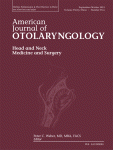
Comparison of repositioning maneuvers for benign paroxysmal positional vertigo of posterior semicircular canal: advantages of hybrid maneuver
Published on: July 25, 2017
 American Journal of Otolaryngology
American Journal of Otolaryngology
Volume 33, Issue 5, September–October 2012, Pages 528-532
Francesco Dispenza MD, PhD, FAINOT, Gautham Kulamarva MS, DNB, DOHNS, MRCS, Alessandro De Stefano MD, PhD, FAINOT
Abstract
Objective
The prevalence of benign paroxysmal positional vertigo (BPPV) is becoming more frequent in elderly population. The presence of comorbid factors has to be considered before assessment as well as before commencing any repositioning treatment. Our aims were evaluation of the maneuvers efficacy and evaluation of the applicability of hybrid maneuver (HM) in patients with physical limitation.
Study design and setting
This is a randomized study in 2 tertiary referral centers.
Intervention
This is a therapeutic intervention.
Patients
All consecutive patients with diagnosis of BPPV of posterior canal matching the inclusion criteria were enrolled. Patients underwent treatment soon after the initial diagnosis in all cases with a repositioning maneuver. The maneuver was casually selected among Semont, Epley, and hybrid. Patients were divided into 3 groups according to the maneuver adopted.
Results
Eighty-eight patients with posterior canal BPPV were enrolled for treatment. Fisher exact test showed that no statistical differences exist between HM and other maneuvers in terms of efficacy. Latency of repositioning nystagmus appeared longer in HM in comparison with other maneuvers (P < .05). Efficacy of maneuvers used for BPPV decreases in case of cupulolithiasis (P < .0001). We found no relationship between age, sex, and length of disturbance on response to maneuvers.
Conclusions
All maneuvers evaluated demonstrated similar efficacy. The HM, as our data showed, allows us to obtain a good percentage of success similar to most maneuvers used. It is also more comfortable for the patients with hip or neck functional limitation allowing an effective treatment of the posterior canal BPPV.